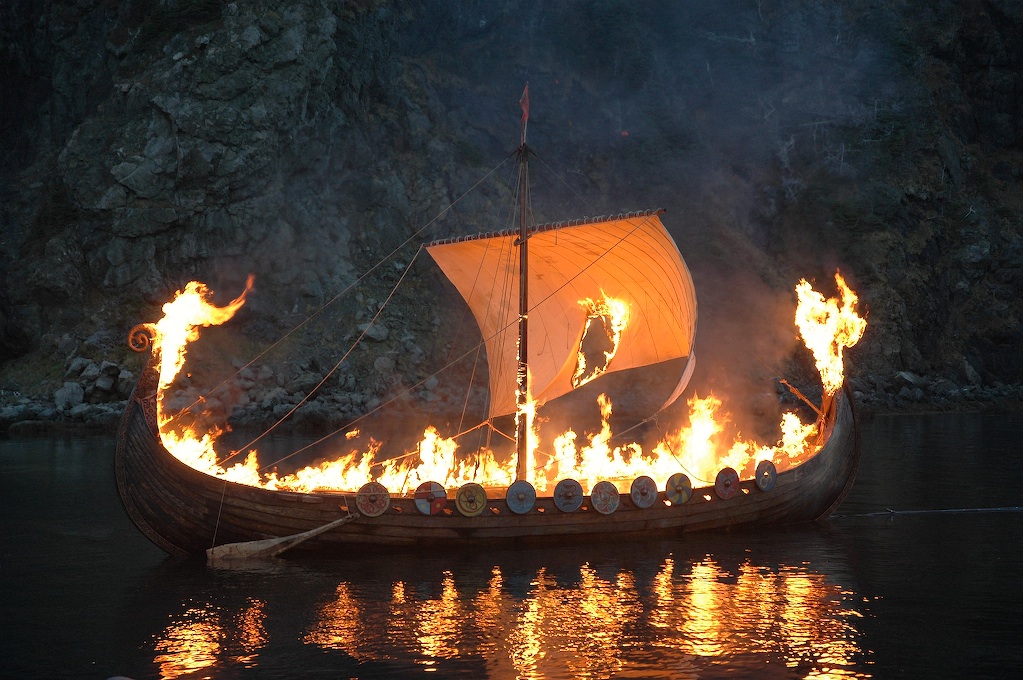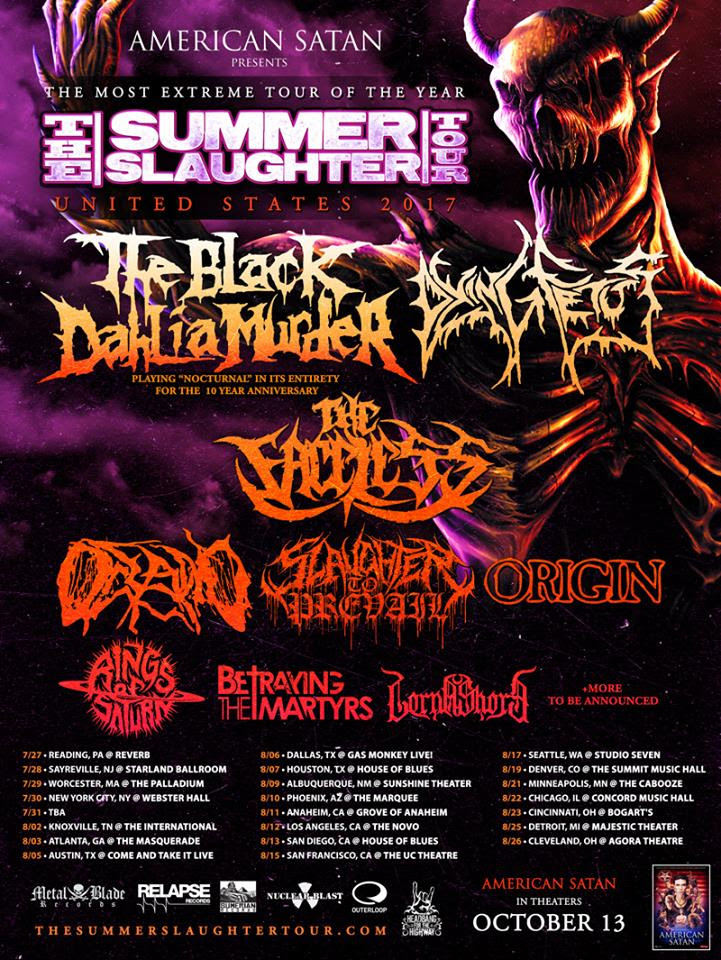The Realities Of Having A Nordic Viking Funeral
 Several times a month, I hear metal fans tell me they wish to have a viking funeral. I always get a good laugh at this as they generally have no clue what they are talking about. For starters, "Vikings" weren't just from Scandanavian countries. There were Scottish, Danish, Swedish, and Norwegian vikings. It was a profession, not a race. Secondly, what people think of as a traditional Nordic Viking rites funeral, where the burning corpse is sent floating out to sea is a myth mainly created in books and by Hollywood. "The 13th Warrior," although a great movie, has caused a lot of confusion. Vikings did not lay their dead in longboats and set them ablaze with a well shot arrow and wait for the wind to carry the soul to Valhalla. Most vikings were buried in the earth following cremation. In the winter months when the ground was frozen solid, they buried the deceased in mounds, again following cremation in a funeral pyre. For ceremonial funerals for high ranking Vikings, the Vikings would place the cremated remains into a stone urn on a boat, and bury it.
Several times a month, I hear metal fans tell me they wish to have a viking funeral. I always get a good laugh at this as they generally have no clue what they are talking about. For starters, "Vikings" weren't just from Scandanavian countries. There were Scottish, Danish, Swedish, and Norwegian vikings. It was a profession, not a race. Secondly, what people think of as a traditional Nordic Viking rites funeral, where the burning corpse is sent floating out to sea is a myth mainly created in books and by Hollywood. "The 13th Warrior," although a great movie, has caused a lot of confusion. Vikings did not lay their dead in longboats and set them ablaze with a well shot arrow and wait for the wind to carry the soul to Valhalla. Most vikings were buried in the earth following cremation. In the winter months when the ground was frozen solid, they buried the deceased in mounds, again following cremation in a funeral pyre. For ceremonial funerals for high ranking Vikings, the Vikings would place the cremated remains into a stone urn on a boat, and bury it.The notion of burying or cremating Vikings on boats is absurd. Boats were far too valuable, especially the longboats. Ship captains would however have the luxury or being buried with their most valuable ship. Most likely if they had a small ceremonial Oseberg, this would have been used. There have been Oseberg ships unearthed that have had sacrificial women and livestock included in the burial that date from the 9th Century AD. There were also no signs of burnt timbers from the ships that the archaeologists unearthed.
According to the Funeral and Cremation Council, a body must be cremated at 1100C for over two hours; and longer for a large body. A typical wood fire, which reaches temperatures of 700-900C over water would never burn hot and long enough to turn flesh and bones to ash. Why is this important? Without cremating the deceased to completion, there would be charred body parts floating ashore. At most, a wood ship set on fire with a body would simply burn away most of the skin and flesh, leaving the bones, muscle tissue, and organs behind for the gulls. This is why vikings cremated the dead first in pyres, then decorated the boats with ornaments, furs, weapons, sacrificial livestock, etc before burying it.
Most countries now have laws regulating how a body is cremated and disposed of. You can't just take your zippo lighter and some gasoline and go to work. There are health concerns as well. A burning body gives off a lot of soot and smoke that can carry pathogens into the air. You also will have naval laws that restrict the dumping of bodies into the ocean. International law does allow for an un-cremated body to be buried at sea. There are several laws however. First, the body cannot be embalmed as the embalming fluid is toxic. The body must be buried at sea as soon as possible, generally within 48 hours due to the no embalming rule and rotting flesh. The body would also need to be wrapped in a shroud or placed in a biodegradable coffin and include a toe tag in the event it happens to become a floater and wash ashore. And lastly, it is recommended to have holes drilled in the bodies head to prevent bloating from the gases being trapped.
California is the only U.S. State that does not permit full body burials at sea. The Environmental Protection Agency (EPA) has regulations for full body burials at sea in the United States. Some of those requirements include a distance of at least three nautical miles from land and in water at least 600 feet deep. Certain areas require water at least 1800 feet deep.
Several burial boats have been unearthed and are on display in Norwegian museums. One thing of note is that none of them have any burnt timbers. There are two Viking ship museums that have raised and unearthed Viking ships on display. There were several Viking ships raised in Denmark that were sunk in the 11th century that are on display at Viking Ship Museum (Roskilde), Roskilde, Denmark. Oslo Norway has several Viking funeral ships that were dug up on display at the Museum of Cultural History, including several Oseberg ships.
Now that we have a lot of inaccuracies out of the way, what is a traditional viking funeral? A traditional Viking funeral consisted of burning the corpse in a open air funeral pyre and burying the cremated remains in an urn. If you were a wealthy man or woman, you would be cremated in a pyre, and buried in a mound with a ship with sacrificial animals and gifts. The key to a viking funeral is the open air pyre for cremation. This allowed the wind to carry the soul to Valhalla.
So what can you do to get as close to a traditional Viking funeral? Most countries now have outlawed cremation in funeral pyres. In the United States, there is only one place allowed to do a pyre cremation. A group in Crestone, Colorado has done the research, obtained the necessary legal permissions and created a permanent cement pyre structure to perform around 12 "open-air cremations" a year. Now that the body has been cremated in a funeral pyre, it is time to get an Oseberg ship. Since you can't legally sacrifice the deceased dog or cat, you can put personal trinkets that he/she enjoyed. From here, you have two options, you can bury the ship and deceased in a mound, or follow some Norse tradition and set the ship ablaze. With the body already cremated, the EPA and Health Board issues earlier aren't an issue. It is best at this point to follow my personal motto of 'it is easier to ask for forgiveness than seek permission' as you aren't going to be allowed to set the ship on fire legally. Maybe call in the Coast Guard after 30 minutes and alert them to an 'accidentally' fire involving your ancient Viking Oseberg ship in the harbor and hope they aren't too suspicious. Just leave your Amon Amarth shirts at home
The reality of sending a full body out to sea and setting it on fire is somewhat mythical and impractical, most likely illegal and a tad bit egoistic.
Read More News
Tags: viking, viking funeral
Jason Fisher May 27, 2011






